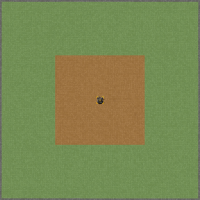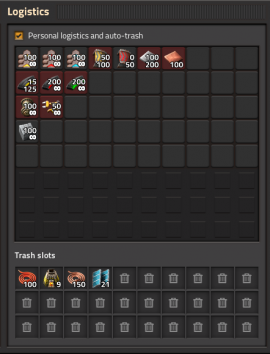User:NKN1396/Logistic network/de: Difference between revisions
No edit summary |
No edit summary |
||
| Line 17: | Line 17: | ||
| {{Imagelink|Logistic robot}} || Moves items between logistic chests.<sup>1</sup> | | {{Imagelink|Logistic robot}} || Moves items between logistic chests.<sup>1</sup> | ||
|- | |- | ||
| {{Imagelink|Construction robot}} || [[Repair pack| | | {{Imagelink|Construction robot}} || [[Repair pack|Repariert]] beschädigte oder ersetzt zerstörte Einheite(entities). [[blueprint|Baut]], [[deconstruction planner|reißt ab]] und [[upgrade planner|upgrades]] entities on command. | ||
|- | |- | ||
| {{Imagelink|Active provider chest}} || Logistic chest: Pushes stored items into the logistic network.<sup>2</sup> | | {{Imagelink|Active provider chest}} || Logistic chest: Pushes stored items into the logistic network.<sup>2</sup> | ||
Revision as of 16:22, 18 August 2020

Ein logistic network ist eine Folge von unterschiedlichen Logistiktruhen und logistic robots, welche allesamt von einem oder mehreren verbundenen roboports abgedeckt sind.
Depending on the type and configuration of the chests and area of the logistic network the robots will transport items between these chests as a power-hungry alternative to moving items manually, or by belts or railway. However, robots offer much higher mobility, since they can fly over obstacles in a beeline.
The player character can also act as requester chest in the logistic network, allowing them to 'request' various items be kept at a set limit within their personal inventory. After researching logistic robotics, they can configure an amount of items; and logistic robots will start to move the specified items from the network to the character's inventory.
Items
| Entity | Description |
|---|---|
| Roboterhangar | Central component of the logistic network in which the robots operate. Roboport coverage defines the area of the logistic network. Robots need to periodically return here to recharge. |
| Logistikroboter | Moves items between logistic chests.1 |
| Bauroboter | Repariert beschädigte oder ersetzt zerstörte Einheite(entities). Baut, reißt ab und upgrades entities on command. |
| Aktive Anbieterkiste | Logistic chest: Pushes stored items into the logistic network.2 |
| Passive Anbieterkiste | Logistic chest: Places stored items at the logistic network's disposal.2 |
| Lagerkiste | Logistic chest: Stores items currently not requested. Can be filtered to only store one type of item. Supplies stored items to the Logistic network.2 |
| Anfragekiste | Logistic chest: Will be filled by logistic robots until the configured amount is reached, or the chest becomes full. Can request multiple different types of items.2 |
| Pufferkiste | Logistic chest: Functions as both a requester chest and passive provider chest.2 |
(1) Default capacity is 1 item per robot. This can be increased by researching Worker robot cargo size (research).
(2) Logistic chests can also be connected to the circuit network with red wire or green wire.
Usage
To start with, just use passive provider- and requester chests. Place the passive provider chests at the output inserters of assembling machines and requester chests at the input (let them request the needed items). Place a roboport, which covers these chests with the inner orange area. Place some logistic bots in the roboport. The robots will fly out of the top hatch and will begin to work. You can now limit the number of produced item with the stack limitation-feature.
The logistic network makes it possible to create complex items in a relatively small factory area, but its throughput is limited by how many robot charge points (roboports) exist in the network.

The basic thing needed for item transportation is roboports. The roboport shows the orange logistic coverage and the green construction coverage when held in the cursor or hovered after placing.
- The orange zone is the logistic network coverage. This is also the maximum distance for connecting two roboports.
- The green zone is the construction area.
Expanding the logistic network
There can be many separate logistic networks. Two roboports are in the same network only if they are connected, so if their logistic areas are touching. Visually this is represented by a dashed yellow line connecting them. To prevent roboports from linking, the player needs to build them far enough away from each other so that the orange zones don't touch.
Bots do not fly migrate from one network to another, unless their home network is destroyed in some way, for example when all roboports are removed or out of power.
Electricity management
1 Watt = 1 Joule/Second
Roboports
Robots may run out of charge on longer journeys which will reduce their flying speed to 20% of their normal speed. Robots that run out of charge will fly to the closest recharge point instead of their original target. This means that they may depart from the original route and even go into the opposite direction, depending on where the closest charging point is.
Roboports have 4 charging slots each, which charge each bot at 1MW, taking 1.5 seconds to charge 1 robot, a roboport also has a 100MJ internal battery allowing bots to keep working for a limited amount of time under low power. Generally, a roboport can charge between 50 and 70 bots per min, 4 at a time, but are not very efficient at charging large queues of bots and can quickly become overworked.
When the charging-queue for the bots gets too long, the bots (and their loads) will slow down. Normally a robot flies to the nearest roboport to recharge. If the queue on that roboport is too long, they eventually choose another port. This is specified by the ratio of <distance to different roboport in tiles> / <queue size of robots waiting>.
Construction and logistic bots
Bots store 1.5MJ of power each, and use 3kW at all times while flying, they use an additional 5kJ for every tile travelled. It must be noted that increasing robot speed does not increase range significantly.
The robots go to recharge when they hit 20% of their energy capacity. That means for 80% of their maximum distance they go straight towards the target, and the other 20% towards a roboport to charge, your roboports should ideally not be further than the 20% of the maximum distance, which is 28 tiles with no upgrades.
The distance can be calculated using the following formula: 1500 / (3 / speed + 5)
For infinite research these are the speeds to input:
Construction: speed = 13.0 * (2.4 + 0.65 * (Level-5))
Logistic: speed = 10.8 * (2.4 + 0.65 * (Level-5))
Mechanics
Losing bots

Worker robots are a priority target of biters, and the enemies will prioritize attacking them over many objects in the vicinity of the robots.
Negative numbers
It is possible to notice negative numbers on the 'Logistic Network'-Screen when looking at network storage or opening the logistic networks GUI the with L.
The logistic network reports the total number of items in provider, buffer and storage chests, minus the amount of items scheduled to be picked up by robots. When a bot starts its journey to pick up items from a chest, it reserves the items in advance by subtracting the items it wants from the total logistics storage. A bot will always reserve the maximum amount that it can carry, even when the box does not currently have that amount. This means that the number can go negative when a bot embarks on a pickup while the box is almost empty. Negative numbers in the logistic network are *not* the deficit of the total number of requested items. If there are no bots picking up any items, there are no negative numbers in the network, regardless of requests in requester chests.
For example, with a full worker robot cargo size bonus, a bot can carry 4 items. If there is only 1 iron plate in the logistic network, and a robot comes to pick it up, it will reserve the full 4 it can carry and the amount in the network will be displayed as follows:
After the robot has picked up the item, the reservation is removed and the number goes back to 0.
The reason this happens is that a bot can be dispatched to pick up an item when there is only 1 item available. While it is travelling to pick up that item, additional items can be put into the chest, and once the bot gets to the chest, it has already reserved those items in advance and can pick them up immediately.
Receiving more items than requested
The delivered number of items in the requester chest can be higher than requested. This depends on the researched Worker robot cargo size-bonus, since bots will always take as much as they can carry if an unlimited amount is available.
Currently, to choose the more distant roboport, the distance must be at most <Number of robots in the queue and on the way> / 2. So, to choose a roboport that is 10 tiles more distant, it has to have 20 less robots waiting in the queue.
Priorities of robots
This overview reflects the priorities in which order the chests are filled/emptied.
Logistic robots on the logistic network look for orders by the chests in this order:
- A requested item is first looked up in active provider chests and in the player's trash slots, then in the storage chests and buffer chests, then the passive provider chests. So, the active provider chests are emptied first, then the storage chests and buffer chests, then the passive provider chests.
- Requests are assigned first for player logistics, then for requester chests, then for buffer chests.
| Source Priority | > > | Target Priority | 1 > > 2 > 3 |
|---|
(1) Requesters with "request from buffer chests" have higher priority than others, the same as a player.
(2) Buffer chests will only ever be a target when having requests specified.
(3) Storage does not "request" items on its own. It receives actively discarded items from a) active providers, b) player trash slots, c) deconstruction, and d) robots that have their orders cancelled while carrying items. Storage is the last priority, and receives only items that have nowhere else to go.
- To place items into storage chests, the bots search for a storage chest that already stores items of the same type, then for one which has its filter set to the item type. If that can't be found, they choose the first storage chest with a free slot from the list, which is sorted by the order they were built in. [2] This is to avoid having storage chests with different items inside, allowing greater organisation.
Distance
When looking to pick up requested items from multiple chests of equal priority, bots will always choose the closest one. [3]
This is however only true when an item is being requested, not when an item is sent away via player trash slots or active provider chests. In the case of items being sent into the logistics network, distance does not matter, instead when chests have the same priority, for example two active provider chests, the bots will alternate between the chests in a round-robin fashion.
Achievements

|
Zustellung erfolgreich Beliefere Deine Spielfigur via Logistikroboter. |

|
Lieferservice Beliefere Deine Spielfigur mit 10.000 Gegenständen via Logistikroboter. |

|
Logistiknetz-Embargo Erforsche eine Technologie mit Wissenschaftspaketen für Weltraumforschung (Basisspiel) bzw. einem Wissenschaftspaket von einem anderen Planeten (Space Age |